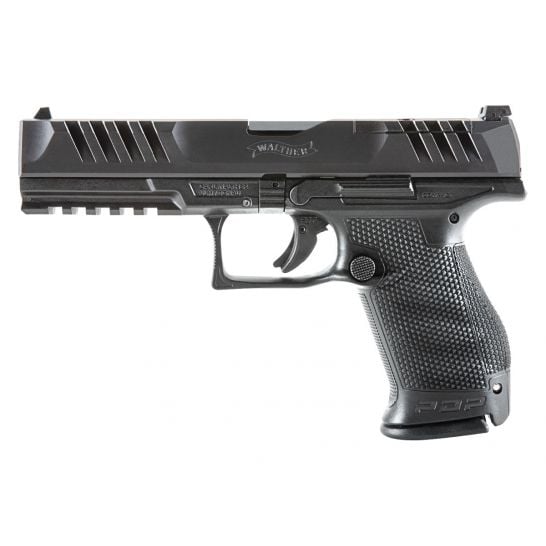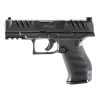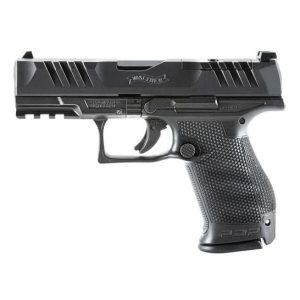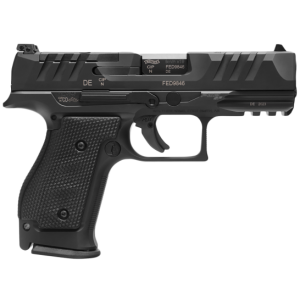Walther PDP Compact 5" 9mm Optic Ready Pistol, Black – 2844222 For Sale
$499.99
The Walther PDP Compact 5″ 9mm Optic Ready Pistol represents a significant advancement in firearm technology, embodying Walther’s dedication to innovation and quality. Designed for both professional and personal defense, this elite handgun ensures preparedness for any situation with its superior ergonomics that enhance user comfort and handling. Key features include SuperTerrain Slide Serrations for reliable grip and manipulation, and the all-new Performance Duty Trigger for precise and consistent shooting. Its optic-ready design facilitates the mounting of red dot sights, aligning with modern preferences for improved targeting accuracy. The Walther PDP Compact exemplifies world-class pistol craftsmanship, with every component engineered for excellence.
Is a PDP compact good for concealed carry?
The Walther PDP Compact is generally considered a good option for concealed carry. It features a compact design, reasonable weight, and efficient ergonomics, which make it suitable for many users looking for a concealed carry firearm. However, the best concealed carry option depends on personal preferences, body type, and carry method. It’s important to handle and, if possible, test fire any firearm to ensure it meets your specific needs and comfort level.
Is Walther PDP better than Glock?
Determining whether the Walther PDP is better than a Glock depends on various factors including personal preferences, intended use, and specific model comparisons.
1. **Ergonomics**: Some users find the Walther PDP to have better ergonomics with a more comfortable grip compared to certain Glock models.
2. **Sights**: The Walther PDP typically comes with better factory sights, often featuring optics-ready capabilities, while Glocks may require upgrades for similar features.
3. **Trigger**: While both brands have reliable triggers, many users praise the PDP for having a smoother and crisper trigger pull right out of the box.
4. **Reliability**: Glocks have a long-standing reputation for reliability and durability under various conditions, although current reports also indicate Walther PDPs perform well in these aspects.
5. **Customization**: Glocks generally have a wider range of aftermarket customization options given their popularity.
6. **Price**: Depending on the model, prices can vary, and you may find one brand offers a better value proposition depending on what features you prioritize.
Ultimately, whether the Walther PDP is better than a Glock can be subjective and is often best determined by handling and testing the firearms to see which one aligns better with your specific needs and preferences.
How much is a Walther PDP 9mm compact?
As of the latest available data, the price of a Walther PDP 9mm Compact typically ranges from $600 to $700 USD, depending on the retailer, location, and any applicable taxes or fees. For the most current pricing, it is best to check with specific gun stores or online retailers.
What is the difference between the Walther PDP full and compact?
The primary differences between the Walther PDP Full Size and the PDP Compact are in their dimensions and capacity. Here are some of the key distinctions:
1. **Size and Weight:**
– **PDP Full Size:** Typically has a larger frame and longer slide, which makes it slightly heavier.
– **PDP Compact:** Has a smaller frame and slide, making it lighter and more suitable for concealed carry.
2. **Barrel Length:**
– **PDP Full Size:** Usually comes with a 4.5-inch barrel.
– **PDP Compact:** Often comes with a shorter 4-inch barrel.
3. **Magazine Capacity:**
– **PDP Full Size:** Often has a higher magazine capacity, around 18 rounds, depending on the specific model and jurisdictional restrictions.
– **PDP Compact:** Typically has a slightly lower capacity, generally around 15 rounds, also subject to jurisdictional restrictions.
4. **Grip Size:**
– **PDP Full Size:** The grip is larger to accommodate a longer magazine, which can be more comfortable for shooters with larger hands.
– **PDP Compact:** The grip is shorter, contributing to better concealability but may be less comfortable for those with larger hands.
Both versions of the PDP share many other features, such as the same ergonomic design, adjustable sights, and the ability to mount optics, which are praised for their user-friendly characteristics and performance.
What is the best compact handgun to carry?
Choosing the best compact handgun for concealed carry depends on personal preferences, specific needs, and intended use. However, several popular options are often recommended due to their reliability, size, and features:
1. **Glock 19** – Known for its reliability, durability, and widespread use in both law enforcement and civilian sectors.
2. **Smith & Wesson M&P Shield** – Offers a slim profile, making it comfortable for concealment, with various calibers available.
3. **Sig Sauer P365** – Features a higher capacity in a compact frame, along with excellent ergonomics.
4. **Springfield Armory Hellcat** – Known for its high capacity and small size, often considered for its balance of comfort and performance.
5. **Ruger LC9s** – A budget-friendly option with a slim design, making it easy to carry.
Your choice should consider factors such as comfort, grip, capacity, safety features, and personal experience. It’s advisable to try a few models at a range if possible to see which one fits you best.
What ammo is best for PDP?
The best ammunition for a Walther PDP, a popular handgun model, typically depends on your specific use case—whether it’s for self-defense, target practice, or competition.
For self-defense, many recommend using high-quality jacketed hollow point (JHP) rounds, such as Speer Gold Dot, Federal HST, or Hornady Critical Duty. These offer reliable expansion and stopping power.
For target practice, full metal jacket (FMJ) rounds are generally preferred due to their affordability and reliability. Brands like Winchester White Box, Federal American Eagle, and Remington UMC are common choices.
Always ensure that the ammunition is compatible with your firearm’s specifications, and consider factors like grain weight and manufacturer recommendations. Regular practice with your chosen self-defense round is also advisable to ensure reliability and familiarity.
What pistol do Navy SEALs prefer?
Navy SEALs commonly use the SIG Sauer P226 as their preferred pistol, although they have been known to use other models as well, such as the Glock 19, depending on the mission requirements and personal preference.
What Walther does John Wick use?
In the John Wick film series, John Wick primarily uses a Walther P99 pistol in “John Wick: Chapter 3 – Parabellum.”
Does Walther PDP have a safety?
The Walther PDP does not have a traditional manual safety. It is designed with other safety features, such as a trigger safety and a drop safety, to ensure safe handling and operation.
What does PDP stand for on Walther?
PDP on Walther stands for “Performance Duty Pistol,” which is a line of semi-automatic pistols designed for personal protection and law enforcement use.
What is a striker fired pistol?
A striker-fired pistol is a type of handgun that uses a striker mechanism instead of a traditional hammer to ignite the cartridge primer and fire the bullet. In striker-fired systems, the firing pin, known as the “striker,” is partially pre-cocked by the action of cycling the slide. When the trigger is pulled, it fully cocks and releases the striker, allowing it to move forward with enough force to ignite the primer and discharge the round.
Striker-fired pistols are generally simpler in design with fewer moving parts, resulting in advantages like a consistent trigger pull, improved reliability, and easier maintenance. These pistols often lack an external hammer, giving them a smoother profile that aids in concealment. Glock is one of the most well-known manufacturers of striker-fired pistols, but many other companies produce them as well.
Who uses the Walther PDP?
The Walther PDP (Performance Duty Pistol) is used by a variety of individuals and groups. This includes law enforcement officers, military personnel, and civilian gun owners who are interested in firearms for self-defense, sport shooting, or personal collection. The PDP is known for its ergonomics, customizable features, and performance, making it appealing to both professionals and enthusiasts.
What does PP stand for in Walther?
In Walther, “PP” stands for “Polizeipistole,” which is German for “police pistol.”
Can the Walther PDP shoot +P ammo?
Yes, the Walther PDP is designed to handle +P ammunition. It is advised to consult the manual and ensure that using +P ammo is appropriate for your specific model to maintain safety and performance standards.
Is the Walther PDP Pro SD compact good for concealed carry?
The Walther PDP Pro SD compact is generally considered a good option for concealed carry. It features a compact size, modular grip, and reliable performance, making it suitable for daily carry. Additionally, it is designed with ergonomics and accuracy in mind, enhancing user experience and confidence. As with any firearm, personal preference, training, and local laws should be considered before making a decision.
| Product Line | PDP |
|---|---|
| Overall Length | 8.5" |
| Magazines Included | 2 |
Be the first to review “Walther PDP Compact 5" 9mm Optic Ready Pistol, Black – 2844222” Cancel reply
Related products
Walther PDP Compact
Walther PDP Compact 4″ OR 10 Round 9mm Pistol, Black – 2854686
Walther PDP Compact




Reviews
There are no reviews yet.